Effect of polyethylene glycol versus lactulose on abdominal pain in children occult constipation: a randomized controlled study
DOI:
https://doi.org/10.47892/rgp.2019.394.994Palabras clave:
Abdominal pain, Constipation, Polyethylene glycol, LactuloseResumen
Introduction and aim: Functional abdominal pain (FAP) is one of the major astrointestinal complaints in childhood. Studies have reported occult constipation (OC) as one of the leading causes of abdominal pain. Recent researches have proposed laxatives as potent therapeutic targets for abdominal pain in patients with OC. However, no study has compared effect of poly ethylene glycol (PEG) and lactulose on occult constipation. Materials and methods: 51 patients aged 4 to 18 years with abdominal pain who had OC (defined as fecal impaction in abdominal X ray) were studied. Demographic and clinical data including age, sex, body weight, height, abdominal pain duration, abdominal pain rate and fecal odor were registered. They were randomly assigned to receive PEG (1gr/kg) or Lactulose (1cc/kg) for at least two weeks. All patients were reevaluated by pain measurement scale after at least two weeks of treatment. Results: It is indicated that the efficacy of PEG for reducing abdominal pain in OC was 48% while it was 37% for Lactulose. This study indicated that this efficacy is not affected significantly by sex and fecal odor, however this efficacy is influenced by age, body weight, abdominal pain duration and abdominal pain rate for both PEG and Lactulose. Conclusion: It could be concluded that PEG is a more efficient drug for treating abdominal pain in occult constipation than Lactulose and its optimum effect can be achieved in elder patients with more severe abdominal pain.
Introduction and aim: Functional abdominal pain (FAP) is one of the major gastrointestinal complaints in childhood. Studies
have reported occult constipation (OC) as one of the leading causes of abdominal pain. Recent researches have proposed
laxatives as potent therapeutic targets for abdominal pain in patients with OC. However, no study has compared effect of
poly ethylene glycol (PEG) and lactulose on occult constipation. Materials and methods: 51 patients aged 4 to 18 years with
abdominal pain who had OC (defined as fecal impaction in abdominal X ray) were studied. Demographic and clinical data
including age, sex, body weight, height, abdominal pain duration, abdominal pain rate and fecal odor were registered. They
were randomly assigned to receive PEG (1gr/kg) or Lactulose (1cc/kg) for at least two weeks. All patients were reevaluated by pain
measurement scale after at least two weeks of treatment. Results: It is indicated that the efficacy of PEG for reducing abdominal
pain in OC was 48% while it was 37% for Lactulose. This study indicated that this efficacy is not affected significantly by sex and
fecal odor, however this efficacy is influenced by age, body weight, abdominal pain duration and abdominal pain rate for both
PEG and Lactulose. Conclusion: It could be concluded that PEG is a more efficient drug for treating abdominal pain in occult
constipation than Lactulose and its optimum effect can be achieved in elder patients with more severe abdominal pain.
Descargas
Métricas
Descargas
Publicado
Cómo citar
Número
Sección
Licencia
Revista de Gastroenterología del Perú by Sociedad Peruana de Gastroenterología del Perú is licensed under a Licencia Creative Commons Atribución 4.0 Internacional..
Aquellos autores/as que tengan publicaciones con esta revista, aceptan los términos siguientes:
- Los autores/as conservarán sus derechos de autor y garantizarán a la revista el derecho de primera publicación de su obra, el cuál estará simultáneamente sujeto a la Licencia de reconocimiento de Creative Commons que permite a terceros compartir la obra siempre que se indique su autor y su primera publicación esta revista.
- Los autores/as podrán adoptar otros acuerdos de licencia no exclusiva de distribución de la versión de la obra publicada (p. ej.: depositarla en un archivo telemático institucional o publicarla en un volumen monográfico) siempre que se indique la publicación inicial en esta revista.
- Se permite y recomienda a los autores/as difundir su obra a través de Internet (p. ej.: en archivos telemáticos institucionales o en su página web) antes y durante el proceso de envío, lo cual puede producir intercambios interesantes y aumentar las citas de la obra publicada. (Véase El efecto del acceso abierto).

















 2022
2022 